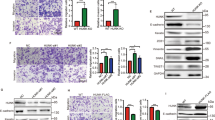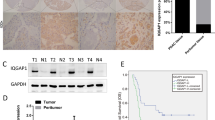Abstract
The p21-activated kinase 5 (PAK5) is overexpressed in advanced cancer and the transcription factor E47 is a direct repressor of E-cadherin and inducer of epithelial–mesenchymal transition (EMT). However, the relationship between PAK5 and E47 has not been explored. In this study, we found that PAK5-mediated E47 phosphorylation promoted EMT in advanced colon cancer. PAK5 interacted with E47 and phosphorylated E47 on Ser39 under hepatocyte growth factor (HGF) stimulation, which decreased cell–cell cohesion, increased cell migration and invasion in vitro and promoted metastasis in a xenograft model. Furthermore, phosphorylation of E47 facilitated its accumulating in nucleus in an importin α-dependent manner, and enhanced E47 binding to E-cadherin promoter directly, leading to inhibition of E-cadherin transcription. In contrast, PAK5-knockdown resulted in blockage of HGF-induced E47 phosphorylation, attenuated association of E47 with importin α and decreased E47 binding to E-cadherin promoter. In addition, we demonstrated a close correlation between PAK5 and phospho-Ser39 E47 expression in colon cancer specimens. More importantly, high expression of phospho-E47 was associated with an aggressive phenotype of colon cancer and nuclear phospho-E47 staining was found in certain cases of colon cancer with metastasis. Collectively, E47 is a novel substrate of PAK5, and PAK5-mediated phosphorylation of E47 promotes EMT and metastasis of colon cancer, suggesting that phosphorylated E47 on Ser39 may be a potential therapeutic target in progressive colon cancer.
This is a preview of subscription content, access via your institution
Access options
Subscribe to this journal
Receive 50 print issues and online access
$259.00 per year
only $5.18 per issue
Buy this article
- Purchase on Springer Link
- Instant access to full article PDF
Prices may be subject to local taxes which are calculated during checkout







Similar content being viewed by others
References
Shapira S, Fokra A, Arber N, Kraus S . Peptides for diagnosis and treatment of colorectal cancer. Curr Med Chem 2014; 21: 2410–2416.
Le Bras GF, Taubenslag KJ, Andl CD . The regulation of cell-cell adhesion during epithelial-mesenchymal transition, motility and tumor progression. Cell Adh Migr 2012; 6: 365–373.
Loboda A, Nebozhyn MV, Watters JW, Buser CA, Shaw PM, Huang PS et al. EMT is the dominant program in human colon cancer. BMC Med Genomics 2011; 4: 9.
Teng Y, Li X . The roles of HLH transcription factors in epithelial mesenchymal transition and multiple molecular mechanisms. Clin Exp Metastasis 2014; 31: 367–377.
Perez-Moreno MA, Locascio A, Rodrigo I, Dhondt G, Portillo F, Nieto MA et al. A new role for E12/E47 in the repression of E-cadherin expression and epithelial-mesenchymal transitions. J Biol Chem 2001; 276: 27424–27431.
Slattery C, McMorrow T, Ryan MP . Overexpression of E2A proteins induces epithelial-mesenchymal transition in human renal proximal tubular epithelial cells suggesting a potential role in renal fibrosis. FEBS Lett 2006; 580: 4021–4030.
Cubillo E, Diaz-Lopez A, Cuevas EP, Moreno-Bueno G, Peinado H, Montes A et al. E47 and Id1 interplay in epithelial-mesenchymal transition. PLoS One 2013; 8: e59948.
Zhao H, Huang A, Li P, Quan Y, Feng B, Chen X et al. E2A suppresses invasion and migration by targeting YAP in colorectal cancer cells. J Transl Med 2013; 11: 317.
Li X, Liu F, Li F . PAK as a therapeutic target in gastric cancer. Expert Opin Ther Targets 2010; 14: 419–433.
He H, Baldwin GS . p21-activated kinases and gastrointestinal cancer. Biochim Biophys Acta 2013; 1833: 33–39.
Whale A, Hashim FN, Fram S, Jones GE, Wells CM . Signalling to cancer cell invasion through PAK family kinases. Front Biosci (Landmark Ed) 2011; 16: 849–864.
Giroux V, Dagorn JC, Iovanna JL . A review of kinases implicated in pancreatic cancer. Pancreatology 2009; 9: 738–754.
Gong W, An Z, Wang Y, Pan X, Fang W, Jiang B et al. P21-activated kinase 5 is overexpressed during colorectal cancer progression and regulates colorectal carcinoma cell adhesion and migration. Int J Cancer 2009; 125: 548–555.
Wang X, Gong W, Qing H, Geng Y, Wang X, Zhang Y et al. p21-activated kinase 5 inhibits camptothecin-induced apoptosis in colorectal carcinoma cells. Tumour Biol 2010; 31: 575–582.
Gu J, Li K, Li M, Wu X, Zhang L, Ding Q et al. A role for p21-activated kinase 7 in the development of gastric cancer. FEBS J 2013; 280: 46–55.
Wang XX, Cheng Q, Zhang SN, Qian HY, Wu JX, Tian H et al. PAK5-Egr1-MMP2 signaling controls the migration and invasion in breast cancer cell. Tumour Biol 2013; 34: 2721–2729.
Fawdar S, Trotter EW, Li Y, Stephenson NL, Hanke F, Marusiak AA et al. Targeted genetic dependency screen facilitates identification of actionable mutations in FGFR4, MAP3K9, and PAK5 in lung cancer. Proc Natl Acad Sci USA 2013; 110: 12426–12431.
Fang ZP, Jiang BG, Gu XF, Zhao B, Ge RL, Zhang FB . P21-activated kinase 5 plays essential roles in the proliferation and tumorigenicity of human hepatocellular carcinoma. Acta Pharmacol Sin 2014; 35: 82–88.
Royal I, Lamarche-Vane N, Lamorte L, Kaibuchi K, Park M . Activation of cdc42, rac, PAK, and rho-kinase in response to hepatocyte growth factor differentially regulates epithelial cell colony spreading and dissociation. Mol Biol Cell 2000; 11: 1709–1725.
Wells CM, Abo A, Ridley AJ . PAK4 is activated via PI3K in HGF-stimulated epithelial cells. J Cell Sci 2002; 115: 3947–3956.
Ogo A, Waterman MR, Kamps MP, Kagawa N . Protein kinase A-dependent transactivation by the E2A-Pbx1 fusion protein. J Biol Chem 1995; 270: 25340–25343.
Teachenor R, Beck K, Wright LY, Shen Z, Briggs SP, Murre C . Biochemical and phosphoproteomic analysis of the helix-loop-helix protein E47. Mol Cell Biol 2012; 32: 1671–1682.
Slattery C, Ryan MP, McMorrow T . E2A proteins: regulators of cell phenotype in normal physiology and disease. Int J Biochem Cell Biol 2008; 40: 1431–1436.
Patel D, Chaudhary J . Increased expression of bHLH transcription factor E2A (TCF3) in prostate cancer promotes proliferation and confers resistance to doxorubicin induced apoptosis. Biochem Biophys Res Commun 2012; 422: 146–151.
Li Y, Shao Y, Tong Y, Shen T, Zhang J, Li Y et al. Nucleo-cytoplasmic shuttling of PAK4 modulates beta-catenin intracellular translocation and signaling. Biochim Biophys Acta 2012; 1823: 465–475.
Mehmood R, Yasuhara N, Fukumoto M, Oe S, Tachibana T, Yoneda Y . Cross-talk between distinct nuclear import pathways enables efficient nuclear import of E47 in conjunction with its partner transcription factors. Mol Biol Cell 2011; 22: 3715–3724.
Murre C, McCaw PS, Baltimore D . A new DNA binding and dimerization motif in immunoglobulin enhancer binding, daughterless, MyoD, and myc proteins. Cell 1989; 56: 777–783.
Schmitz R, Young RM, Ceribelli M, Jhavar S, Xiao W, Zhang M et al. Burkitt lymphoma pathogenesis and therapeutic targets from structural and functional genomics. Nature 2012; 490: 116–120.
Tijchon E, Havinga J, van Leeuwen FN, Scheijen B . B-lineage transcription factors and cooperating gene lesions required for leukemia development. Leukemia 2013; 27: 541–552.
Lee SH, Hao E, Kiselyuk A, Shapiro J, Shields DJ, Lowy A et al. The Id3/E47 axis mediates cell-cycle control in human pancreatic ducts and adenocarcinoma. Mol Cancer Res 2011; 9: 782–790.
Spender LC, Inman GJ . Developments in Burkitt's lymphoma: novel cooperations in oncogenic MYC signaling. Cancer Manag Res 2014; 6: 27–38.
Chiaro C, Lazarova DL, Bordonaro M . Tcf3 and cell cycle factors contribute to butyrate resistance in colorectal cancer cells. Biochem Biophys Res Commun 2012; 428: 121–126.
Peinado H, Marin F, Cubillo E, Stark HJ, Fusenig N, Nieto MA et al. Snail and E47 repressors of E-cadherin induce distinct invasive and angiogenic properties in vivo. J Cell Sci 2004; 117: 2827–2839.
Moreno-Bueno G, Cubillo E, Sarrio D, Peinado H, Rodriguez-Pinilla SM, Villa S et al. Genetic profiling of epithelial cells expressing E-cadherin repressors reveals a distinct role for Snail, Slug, and E47 factors in epithelial-mesenchymal transition. Cancer Res 2006; 66: 9543–9556.
Cochrane SW, Zhao Y, Welner RS, Sun XH . Balance between Id and E proteins regulates myeloid-versus-lymphoid lineage decisions. Blood 2009; 113: 1016–1026.
Coma S, Amin DN, Shimizu A, Lasorella A, Iavarone A, Klagsbrun M . Id2 promotes tumor cell migration and invasion through transcriptional repression of semaphorin 3 F. Cancer Res 2010; 70: 3823–3832.
Chen XS, Zhang YH, Cai QY, Yao ZX . ID2: A negative transcription factor regulating oligodendroglia differentiation. J Neurosci Res 2012; 90: 925–932.
Johnson SE, Wang X, Hardy S, Taparowsky EJ, Konieczny SF . Casein kinase II increases the transcriptional activities of MRF4 and MyoD independently of their direct phosphorylation. Mol Cell Biol 1996; 16: 1604–1613.
Sloan SR, Shen CP, McCarrick-Walmsley R, Kadesch T . Phosphorylation of E47 as a potential determinant of B-cell-specific activity. Mol Cell Biol 1996; 16: 6900–6908.
Lluis F, Ballestar E, Suelves M, Esteller M, Munoz-Canoves P . E47 phosphorylation by p38 MAPK promotes MyoD/E47 association and muscle-specific gene transcription. EMBO J 2005; 24: 974–984.
Hwang-Verslues WW, Chang PH, Wei PC, Yang CY, Huang CK, Kuo WH et al. miR-495 is upregulated by E12/E47 in breast cancer stem cells, and promotes oncogenesis and hypoxia resistance via downregulation of E-cadherin and REDD1. Oncogene 2011; 30: 2463–2474.
Lingbeck JM, Trausch-Azar JS, Ciechanover A, Schwartz AL . E12 and E47 modulate cellular localization and proteasome-mediated degradation of MyoD and Id1. Oncogene 2005; 24: 6376–6384.
Shao Y, Li Y, Zhang J, Liu D, Liu F, Zhao Y et al. Involvement of histone deacetylation in MORC2-mediated down-regulation of carbonic anhydrase IX. Nucleic Acids Res 2010; 38: 2813–2824.
Li X, Ke Q, Li Y, Liu F, Zhu G, Li F . DGCR6L a novel PAK4 interaction protein, regulates PAK4-mediated migration of human gastric cancer cell via LIMK1. Int J Biochem Cell Biol 2010; 42: 70–79.
Berchuck A, Soisson AP, Clarke-Pearson DL, Soper JT, Boyer CM, Kinney RB et al. Immunohistochemical expression of CA 125 in endometrial adenocarcinoma: correlation of antigen expression with metastatic potential. Cancer Res 1989; 49: 2091–2095.
Guo Q, Su N, Zhang J, Li X, Miao Z, Wang G et al. PAK4 kinase-mediated SCG10 phosphorylation involved in gastric cancer metastasis. Oncogene 2014; 33: 3277–3287.
Acknowledgements
We are grateful to Drs Stephen J Brandt and Akira Kato for providing essential expression vectors. We also thank Dr Funan Liu for technical assistance. This work was supported by grants from the National Natural Science Foundation of China (Nos 90813038, 31371424, 31171360, 31000627, 81201659 and 81230077), Doctoral fund of Ministry of Education of China (No. 20102104110016) and Ministry of Education of China (IRT 13101).
Author information
Authors and Affiliations
Corresponding author
Ethics declarations
Competing interests
The authors declare no conflict of interest.
Additional information
Supplementary Information accompanies this paper on the Oncogene website
Rights and permissions
About this article
Cite this article
Zhu, G., Li, X., Guo, B. et al. PAK5-mediated E47 phosphorylation promotes epithelial–mesenchymal transition and metastasis of colon cancer. Oncogene 35, 1943–1954 (2016). https://doi.org/10.1038/onc.2015.259
Received:
Revised:
Accepted:
Published:
Issue Date:
DOI: https://doi.org/10.1038/onc.2015.259
This article is cited by
-
Prognostic significance of PAK family kinases in acute myeloid leukemia
Cancer Gene Therapy (2020)
-
E2A attenuates tumor-initiating capacity of colorectal cancer cells via the Wnt/beta-catenin pathway
Journal of Experimental & Clinical Cancer Research (2019)
-
New insights into the mechanisms of epithelial–mesenchymal transition and implications for cancer
Nature Reviews Molecular Cell Biology (2019)
-
PAK5 promotes the migration and invasion of cervical cancer cells by phosphorylating SATB1
Cell Death & Differentiation (2019)
-
PAK5-mediated phosphorylation and nuclear translocation of NF-κB-p65 promotes breast cancer cell proliferation in vitro and in vivo
Journal of Experimental & Clinical Cancer Research (2017)



